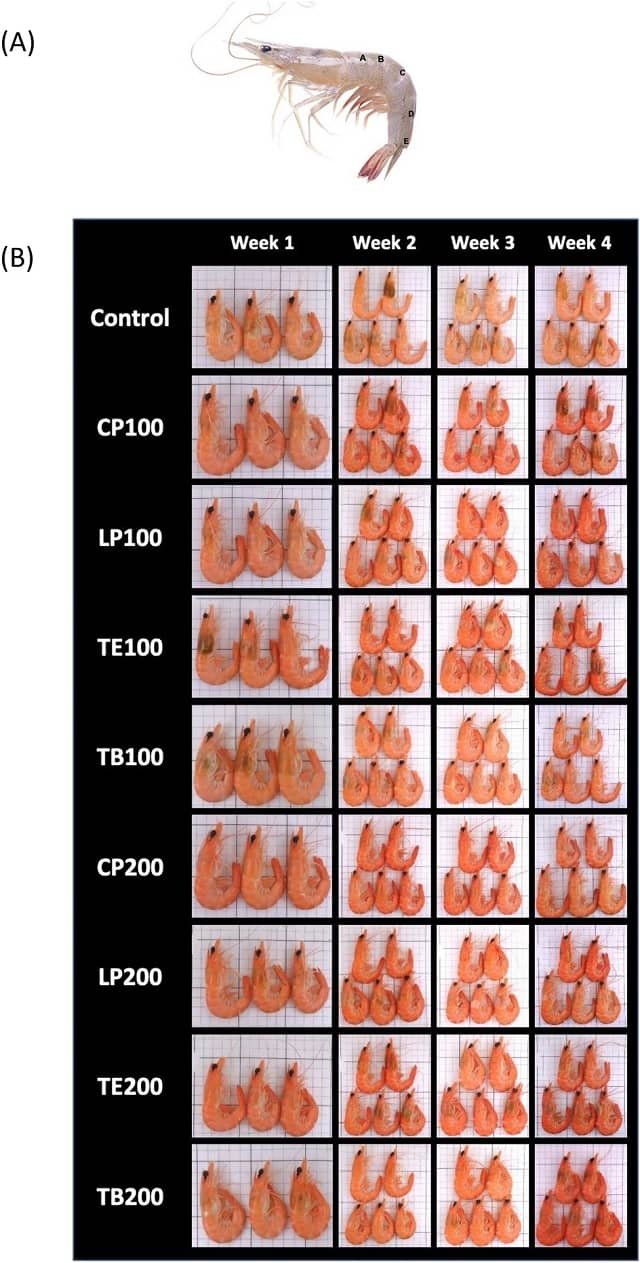Currently, there is little doubt that the future of shrimp aquaculture, as well as other species, cannot heavily rely on fishmeal ingredients anymore, and the role of terrestrial-derived plant inputs becomes more evident.
However, a high percentage of inclusion of plant-based meals in aquaculture diets poses a problem due to the presence of antinutritional compounds. In this context, organic acids have become an important input in aquaculture diets due to their beneficial effects on aquatic organisms.
Scientists from Kasetsart University and the National Chung Hsing University evaluated the effect of tributyrin on the growth performance, survival, hypoxia tolerance, and digestibility of Pacific white shrimp (Litopenaeus vannamei) fed with diets containing 25% and 50% soybean meal (SBM).
They also investigated the effects of tributyrin on hypoxia stress tolerance and nutrient digestibility.
Experimental Diets
The scientists formulated six experimental diets: (1) 25% soybean meal (SBM) without tributyrin; (2) 25% SBM with 0.05% tributyrin; (3) 25% SBM with 0.1% tributyrin; (4) 50% SBM without tributyrin; (5) 50% SBM with 0.05% tributyrin; and (6) 50% SBM with 0.1% tributyrin.
“The experimental diets were prepared by mixing tributyrin with the other ingredients and converted into pellets using a pelleting machine,” the study explains.
Tributyrin
Short-chain fatty acids or organic acids have traditionally been used as preservatives in food and feed. However, the addition of these compounds in aquaculture has received little attention.
Many studies have shown the benefits of using organic acids in aquatic animals, such as improved growth performance, nutrient utilization, antioxidant capacity, immune response, and disease resistance.
Stay Always Informed
Join our communities to instantly receive the most important news, reports, and analysis from the aquaculture industry.
Tributyrin is an organic acid among the most promising feed additives. This compound is water-insoluble and less prone to leaching when applied as a topcoat on pelleted feeds.
Effect of Tributyrin on Growth
The study results revealed the detrimental effects of high soybean meal diets (50% SBM) on vannamei shrimp in all investigated parameters, including lower growth performance, lower survival rate, and higher feed conversion ratio.
“Shrimps fed with diets containing 25% SBM and 0.1% tributyrin had significantly higher weight gain than groups fed with 0.05% tributyrin and control (0% tributyrin). However, the growth-promoting effect of 0.1% tributyrin was absent in shrimps fed with 50% SBM,” the scientists report.
They also highlight that shrimp fed with tributyrin showed a significant improvement in survival rate at both levels of soybean meal.
Effects on Pathogen Resistance
According to the study results, the abilities to resist hypoxic stress and nutrient digestibility were also reduced when shrimp were fed with 50% SBM compared to 25% SBM, regardless of the inclusion rate of tributyrin.
Based on the study results, “Although our study did not evaluate the in vitro antibacterial or anti-biofilm properties of tributyrin or its active compound butyrate, significant reductions in hepatopancreatic and intestinal Vibrio spp. counts indicate that dietary tributyrin at doses of 0.05% to 0.1% was effective against in vivo Vibrio spp. proliferation at SBM levels of 25% and 50%.”
Nutrient Digestibility
The scientists revealed that the effect of tributyrin in the diet on the apparent digestibility of nutrients was significant only for lipid digestibility in the 25% soybean meal group supplemented with 0.1% tributyrin but not for dry matter and protein.
Conclusion
According to the researchers, tributyrin is a promising feed additive for shrimp aquaculture.
“Dietary tributyrin at a 0.1% dosage significantly improved weight gain in shrimp fed with a 25% SBM diet, but the growth-promoting effect was not observed in those fed with a 50% SBM diet during this study,” the scientists conclude.
Furthermore, supplementation with 0.1% tributyrin significantly improved survival rates by reducing Vibrio spp. counts in the hepatopancreas and intestine, and increasing shrimp’s ability to tolerate hypoxic stress in the 25% and 50% SBM groups.
Finally, “the supplementation of tributyrin in aquaculture feeds, especially in feeds containing a moderate level of SBM (25%), can help improve the quality and quantity of shrimp production and, consequently, lead to higher revenues for shrimp farmers,” the researchers emphasized.
The study was funded by the Aquaculture Business Research Center (ABRC), Faculty of Fisheries, Kasetsart University, Thailand.
Contact
Niti Chuchird
Department of Fishery Biology
Faculty of Fisheries, Kasetsart University,
Bangkok 10900, Thailand.
Email: ffisntc@ku.ac.th
Referencia (acceso abierto)
Rairat, T., Phansawat, P., Keetanon, A., Kachapol, P., Kumphaphat, S., Kitsanayanyong, L., Chou, C.-C., & Chuchird, N. (2023). Effects of tributyrin on the growth performance, survival, tolerance to hypoxic stress, and nutrient digestibility of Pacific white shrimp, Litopenaeus vannamei, fed different levels of soybean meal. Journal of the World Aquaculture Society, 1–14. https://doi.org/10.1111/jwas.13016
Editor at the digital magazine AquaHoy. He holds a degree in Aquaculture Biology from the National University of Santa (UNS) and a Master’s degree in Science and Innovation Management from the Polytechnic University of Valencia, with postgraduate diplomas in Business Innovation and Innovation Management. He possesses extensive experience in the aquaculture and fisheries sector, having led the Fisheries Innovation Unit of the National Program for Innovation in Fisheries and Aquaculture (PNIPA). He has served as a senior consultant in technology watch, an innovation project formulator and advisor, and a lecturer at UNS. He is a member of the Peruvian College of Biologists and was recognized by the World Aquaculture Society (WAS) in 2016 for his contribution to aquaculture.




